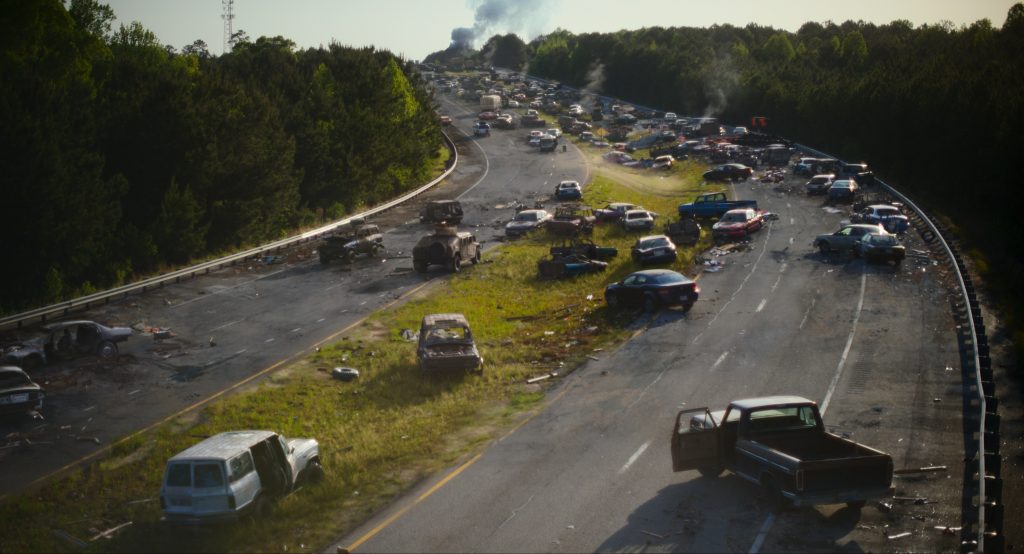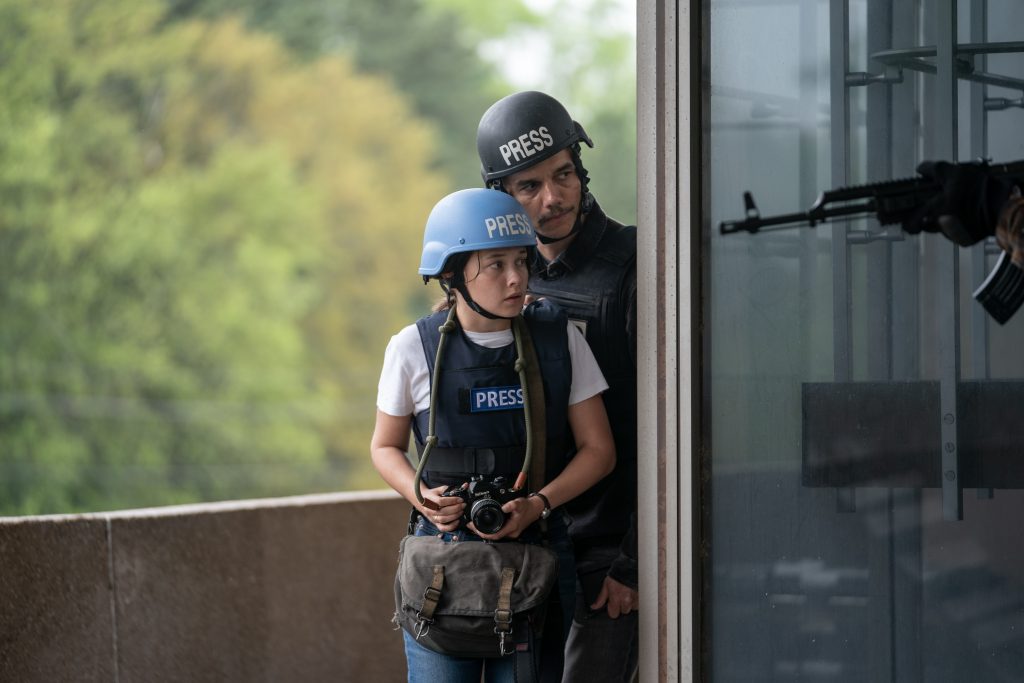Writer/director Alex Garland isn’t American, having been born and raised in London, England. And yet his latest film, Civil War, deftly captures an America torn apart by conflict and violence on an overwhelming scale. The follow-up to 2022’s bizarre horror Men is a major diversion from his prior work, both in subject matter and size. With a $50 million dollar budget (producer A24’s most expensive film to date), Civil War is a brutal and shocking journey featuring a fantastic ensemble cast, led by one of Kirsten Dunst’s best performances of her career.
In Civil War, the United States is embroiled in conflict. Multiple states have seceded, and are waging war against federal government forces. The President (Nick Offerman) is bunkered down in the White House, his side clearly losing the war, and yet his voice and image are constantly present, claiming victories and rejecting peace deals. So many questions can be posed: What prompted the secession of the states? Why are California and Texas working together? What the heck is the Florida Alliance? None are answered. Garland doesn’t bother with a backstory, and he doesn’t need to. Civil War‘s focus is entirely on its cast of characters and the disintegration of the American way of life.
We meet Lee (Kirsten Dunst), a war photographer, in the eerily empty streets of New York City. A veteran of war journalism, she seemingly shows zero emotion as she takes images of protests over water distribution, and she maintains that stoicism photographing the aftermath of the suicide bombing moments later. Lee’s clearly seen too much of this carnage, and when she saves a young amateur photographer named Jessie (Cailee Spaeny) from the blast, a brief twinkle of emotionality is present; Lee doesn’t want Jessie to become like her.

Despite Lee warning her, Jessie (infatuated with meeting her hero) convinces Lee’s colleagues Joel and Sammy (Wagner Moura and Stephen McKinley Henderson respectively) to let her join them on their journey. Their goal is a lofty and dangerous one: interview the President of the United States before rebel forces reach the White House. In a way, this road trip across America invokes Martin Sheen’s boat ride through Vietnam and Cambodia in Apocalypse Now, as every location they pass through brings a different perspective to the conflict. Garland invites you to view these events as an objective viewer. This conflict is fictional, the adversaries and causes unknown, and there isn’t a side to root for. You become just another passenger in their van, documenting their experiences and moving on.
The format of Civil War leads to consistent time spent with the same few characters; their journey is truly the only narrative thread. This allows for intimate time with our protagonists, allowing us to understand their motivations and to see how they react differently to events on their trip.
Apocalypse in the Heartland
The concept of a Second American Civil War is unthinkable, and Garland’s visual choices remind us just how surreal a conflict on this scale could be. In one early moment, Lee stops the car near an abandoned strip mall, and instructs Jessie to take a picture: a crashed military helicopter is entangled in power lines, the wreckage just a few feet in front of a typical American department store. The dichotomy of rubble and burnt bodies interspersed with American suburbia feels unreal, like someone has plucked images of warfare in places like Gaza and Afghanistan and Photoshopped them onto Everywhere, USA. Yet, these images don’t feel produced or overblown; Garland captures an America that feels too real, too possible.

In one tense scene, the group comes across a seemingly abandoned winter holiday display. As a sudden gunshot pierces their windshield, they soon realize that they’ve driven into a sniper battle. A curious Joel asks the sniper and his spotter what side they’re on, and who they’re shooting at. The spotter shrugs and simply says, “They’re trying to kill us. We’re trying to kill them.”
The various locations that Lee and her posse find themselves at are distinct, able to capture the impacts that such a conflict could have on all types of Americans. However, the final sequence of Civil War contains some of its most powerful imagery coupled with the thrilling and tense moments of a military assault on the White House. Garland worked with military advisor Ray Mendoza, and the effectiveness of their collaboration is most prominent in this closing assault. The callouts and strategies that the soldiers utilize to take down their enemy never feel simplified or exaggerated for the audience. Instead, troops move with surgical precision from hallway to hallway, helicopters provide close air support, and soldiers take cover from gunfire behind whatever is available to them. It’s well-oiled chaos, and you glean that these men and women are doing exactly what they’re trained for: killing. Mendoza has been promoted to co-director alongside Garland for their new untitled war film, and it’ll be interesting to see how his advisory role will transition to the profession of directing.

Sound and Fury
On a technical scale, Civil War is an incredible feat, merging gorgeous and haunting visuals with sound design that cocoons your ears in noise. Every gunshot, explosion, and engine roar feels tangible and oh so dangerous, ratcheting up the tension. The many transitions between quiet moments and raucous violence are jarring, exemplifying how dangerous and unpredictable this journey is. A single bullet could end the journey for any one of our protagonists, an idea that remains in the back of your mind. At night, distant gunfire crackles and lights up the night sky, a potential danger that’s terrifying to Jessie. Her new colleagues barely react; they’re used to these sounds. To Lee and Joel, they’re no different from the chirps of the crickets.
Lee somberly remarks during one of the film’s quieter moments, “Every time I survived a war zone, I thought I was sending a warning home: don’t do this. But here we are.” Civil War is that warning, a film that doesn’t entertain so much as terrify. It’s a reminder just how quickly a nation can splinter, and a tribute to the journalists that put their lives on the line to insert that reminder into our daily lives.
Civil War releases in theaters on April 12th.
For more Reviews, make sure to check back to That Hashtag Show.

![Civil War – A Visceral American Horror Story [REVIEW]](https://thathashtagshow.com/wp-content/uploads/2024/04/project_20240410_1316416-01-1280x640.png)
![The Last Drive-In With Joe Bob Briggs (S4, Ep. 3) Isolation And Superstition [Review]](https://thathashtagshow.com/wp-content/uploads/2022/05/279833653_1167937200691508_7982016109519811810_n-440x264.png)
![Starstruck Season 2 – A Frustrating & Hilarious Journey [Review]](https://thathashtagshow.com/wp-content/uploads/2022/03/project_20220325_1443227-01-440x264.png)
![Nine Days: A Life-Affirming Masterpiece [REVIEW]](https://thathashtagshow.com/wp-content/uploads/2021/07/project_20210720_2153587-01-440x264.png)
![One True Loves misses the mark [REVIEW]](https://thathashtagshow.com/wp-content/uploads/2023/04/project_20230406_1006455-01-440x264.png)